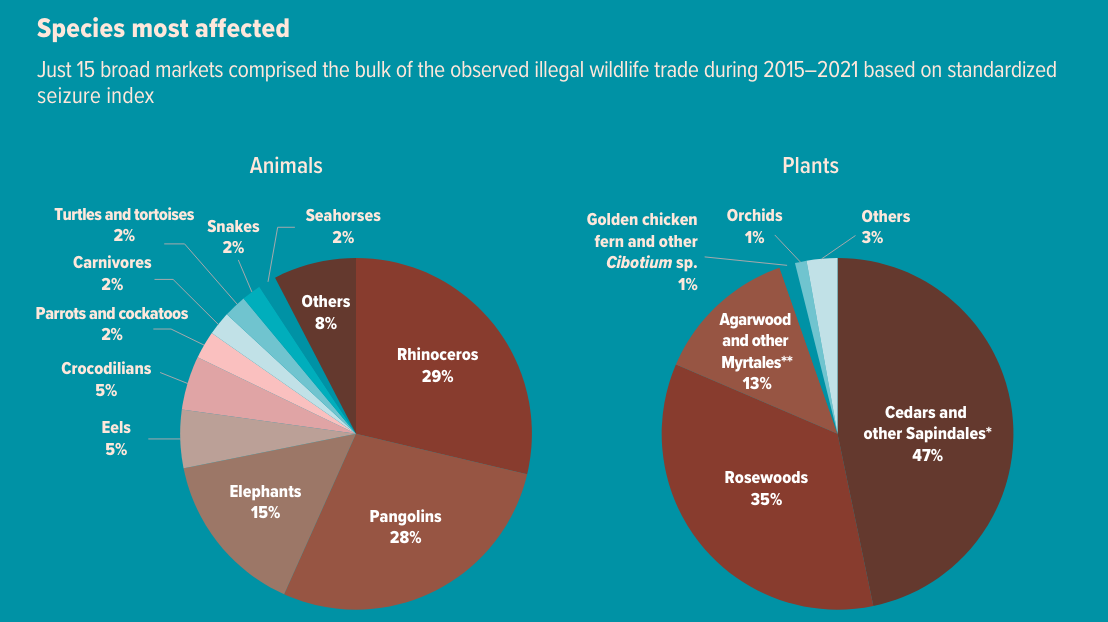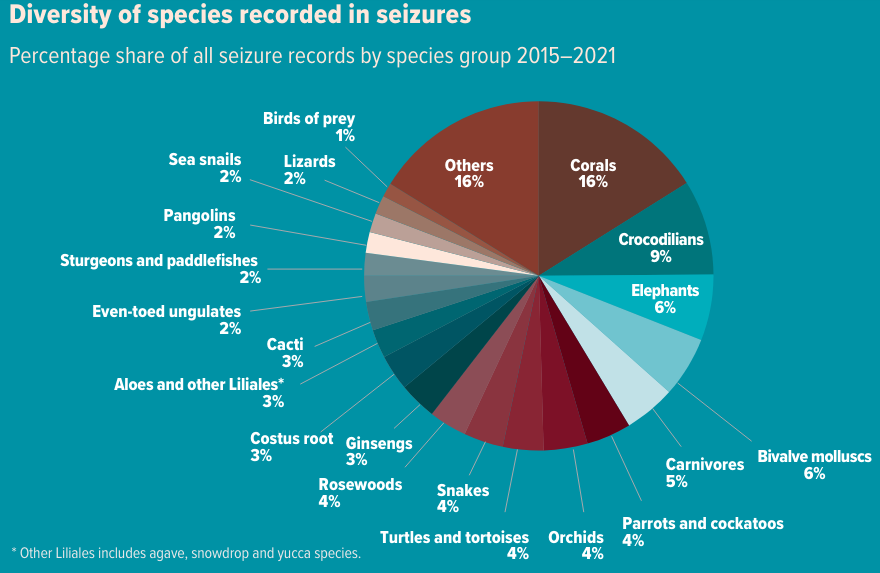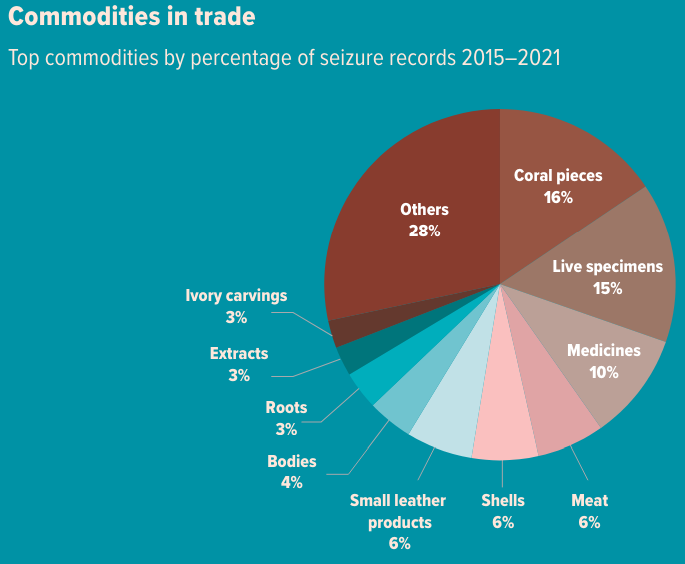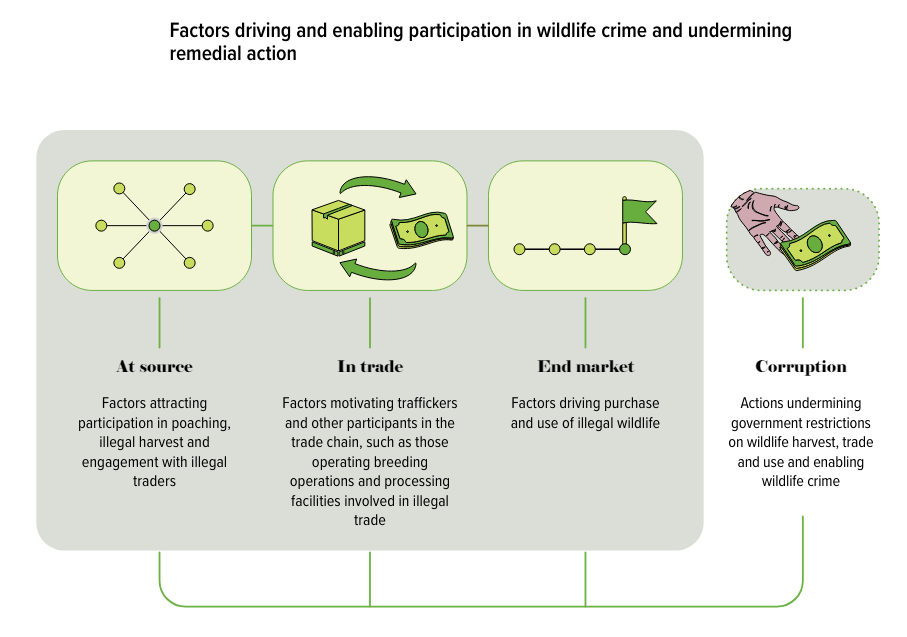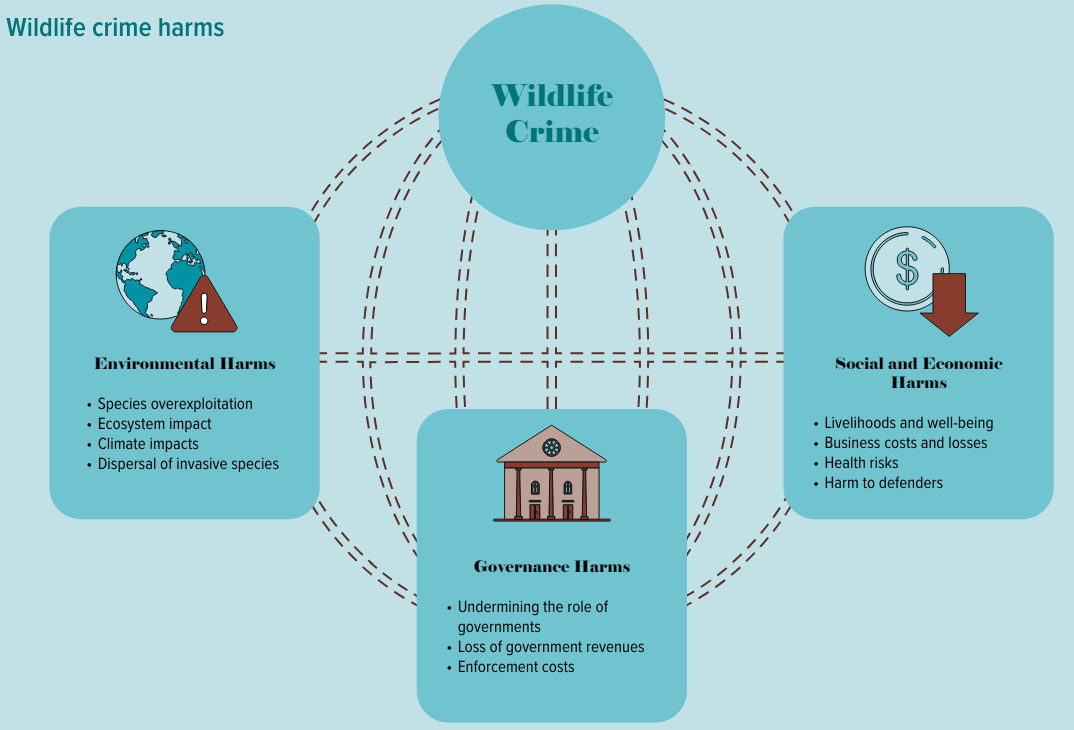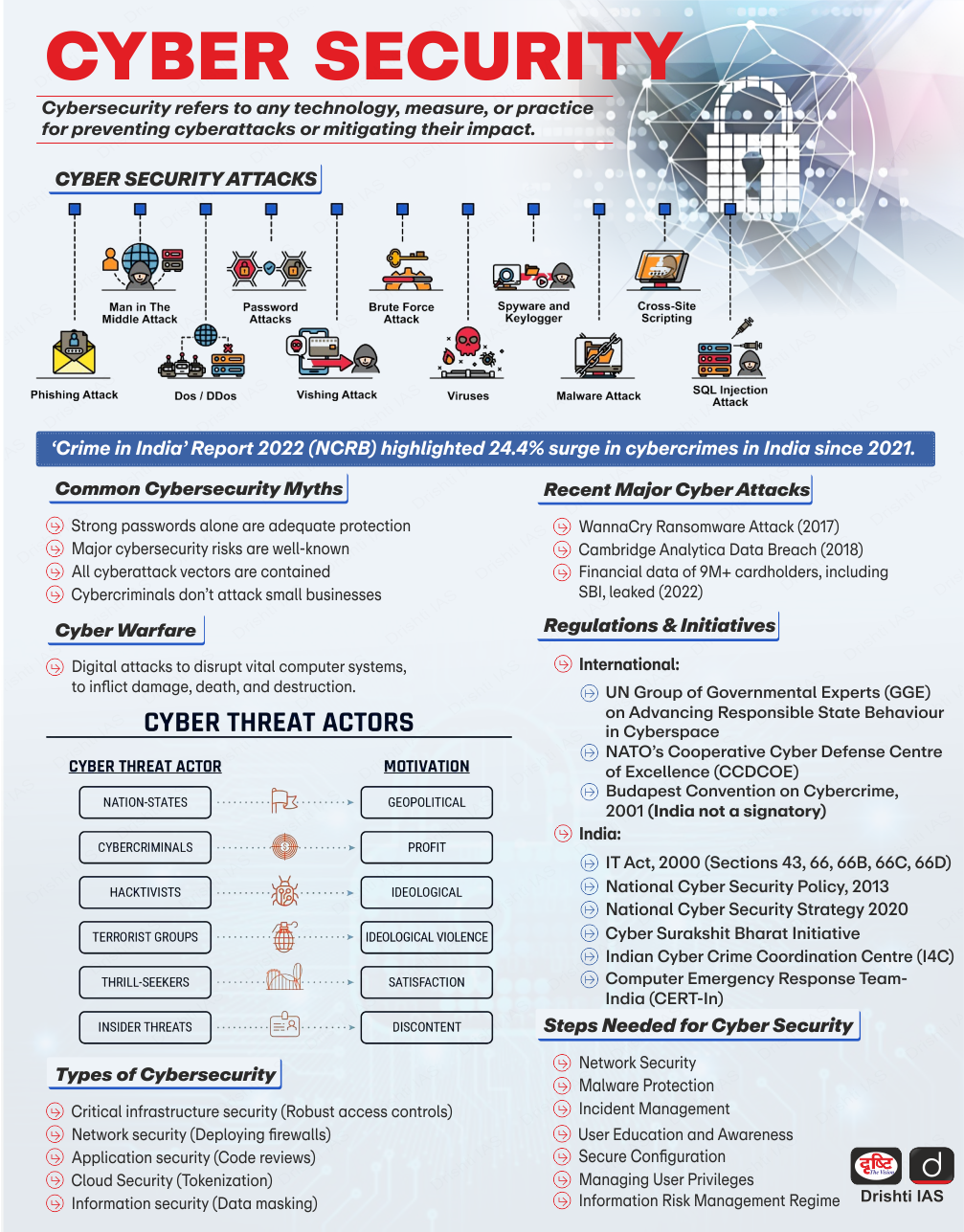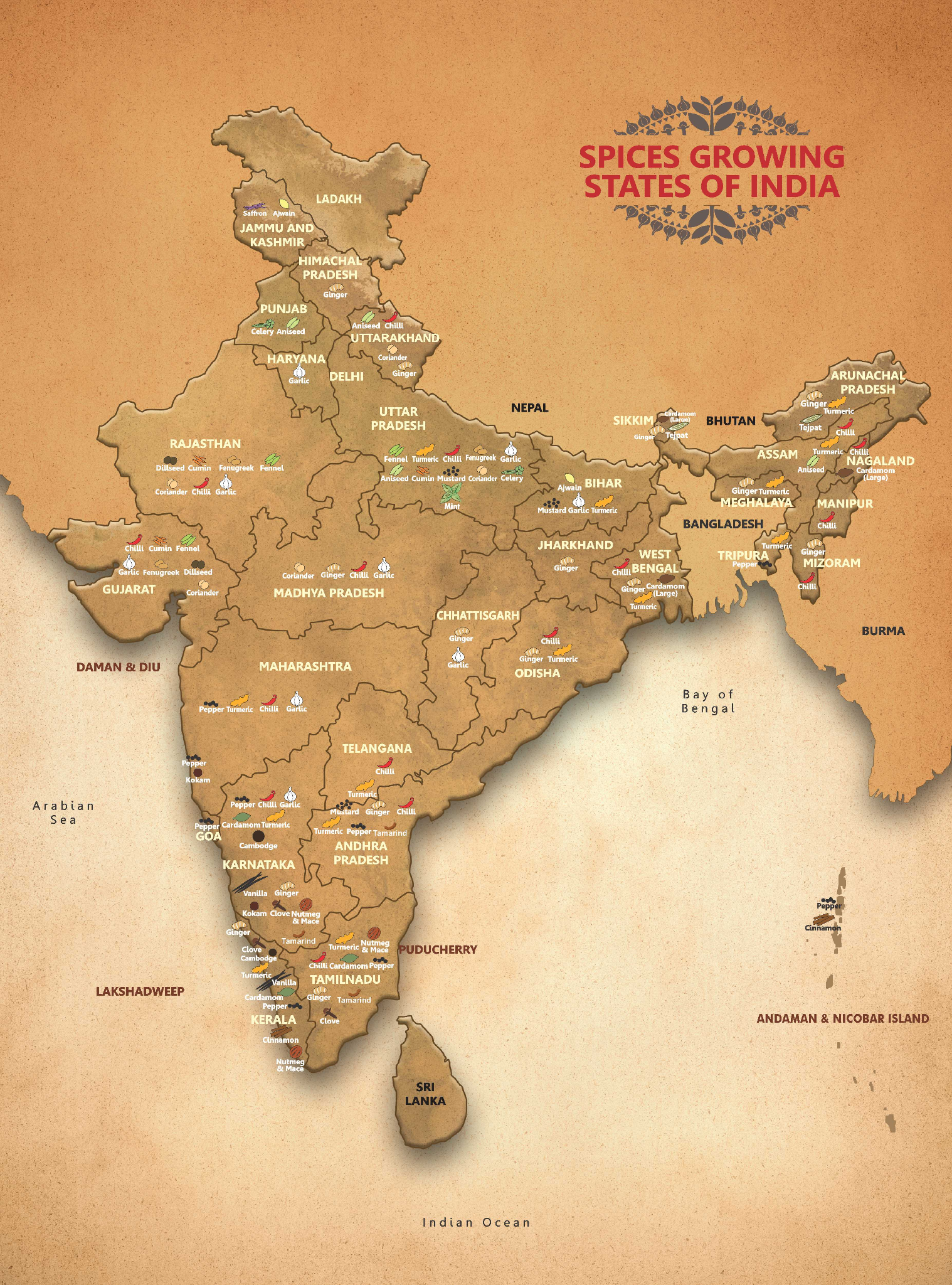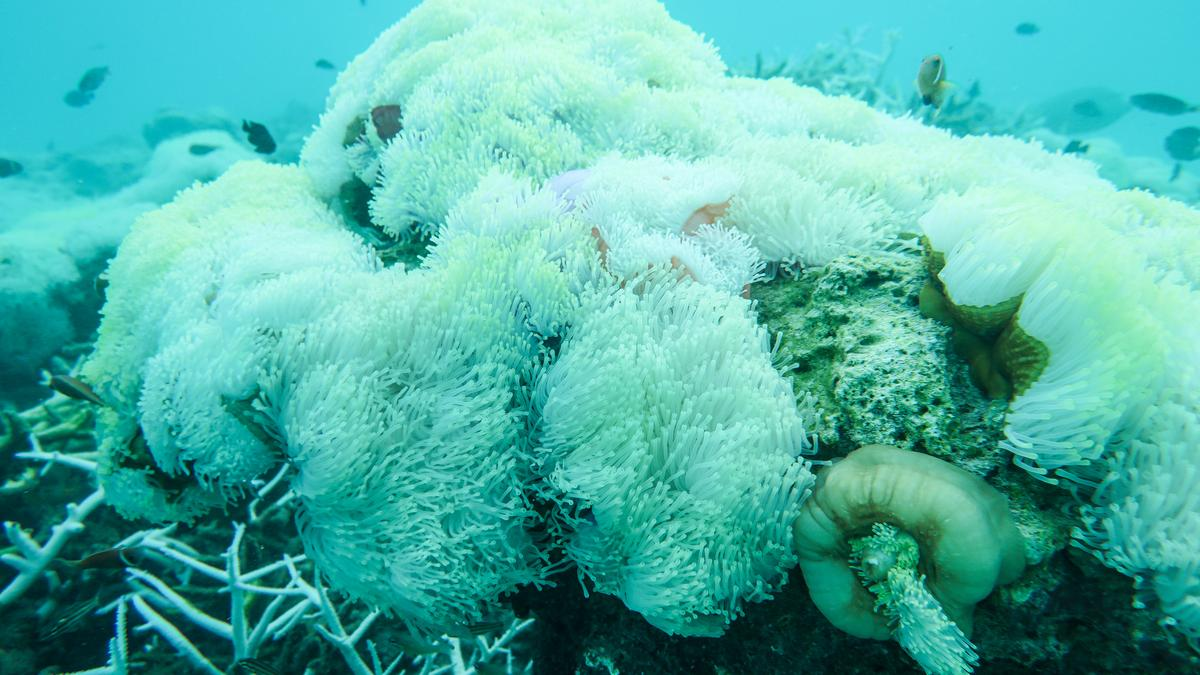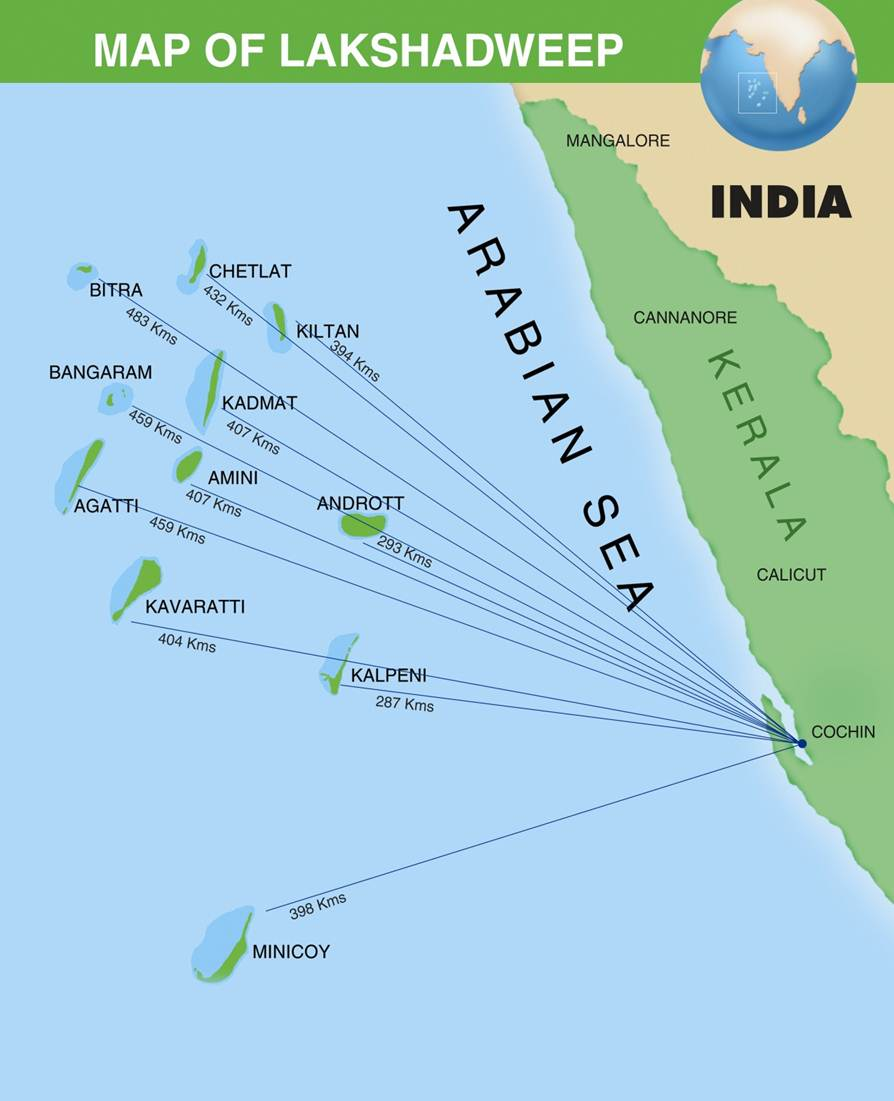World Wildlife Crime Report 2024
For Prelims: Money Laundering and the Illegal Wildlife Trade, Organized Crime, Pangolin, Rhino Poaching.
For Mains: Organised crime and Wildlife Trafficking, Wildlife Conservation
Why in News?
The UN Office on Drugs and Crime (UNODC) has recently released the 3rd edition of a report titled the World Wildlife Crime Report 2024.
- It provided a comprehensive analysis of the illegal wildlife trade from 2015 to 2021.
United Nations Office on Drugs and Crime
- It was established in 1997 and was named as a United Nations Office on Drugs and Crime (UNODC) in 2002.
- It acts as the Office for Drug Control and Crime Prevention by combining the United Nations International Drug Control Program (UNDCP) and the Crime Prevention and Criminal Justice Division of the United Nations Office at Vienna.
What are the Key Highlights of the Report?
- Trafficking in Animal and Plant Products:
- The rhino (animal) and the cedar (plant) - most affected by global illegal wildlife trade during 2015-2021.
- Rhino horn - largest portion of the illegal animal trade at 29%, followed by pangolin scales at 28% and elephant ivory at 15%.
- Other illicitly traded animal species - Eels(5%), crocodilians(5%), parrots and cockatoos(2%), carnivores, turtles and tortoises, snakes, and seahorses.
- Major illegally traded plants - Cedars and other Sapindales like mahogany, holy wood, and Guiacum made up the biggest market at 47%, followed by rosewoods at 35% and agarwood and other myrtales at 13%.
- The rhino (animal) and the cedar (plant) - most affected by global illegal wildlife trade during 2015-2021.
- Commodities in Trade:
- Among the commodities, coral pieces were found the most and comprised 16% of all seizures during 2015-2016; live specimens - 15%, while medicines made of animal products constituted 10% of all seizures.
- Bone Processing to Move to the Source Nations:
- Report highlighted that traditionally, bones are processed in destination countries (Far East) but may now be processed closer to where the animals are sourced (Africa, Latin America, Asia).
- This is concerning because it would be Easier to traffic as processing like boiling bones into paste makes it easier to smuggle, it would be unknown if this is for local use, export, or both.
- The report notes concerns about substituting lion and jaguar bones for tiger bones, which are highly valued in traditional Chinese medicine.
- Off-Track from SDG Goal No.15.7:
- In 2024, the UNODC introduced a new indicator to track progress on SDG target 15.7, which aims to stop illegal wildlife trafficking.
- Rising Illegal Trade suggests that the proportion of illegal wildlife trade compared to all wildlife trade (legal and illegal) has been increasing since 2017.
- The problem worsened during the Covid-19 pandemic (2020-2021), with wildlife seizures reaching their highest levels at 1.4-1.9% of global trade.
- Compared to 0.5-1.1% in previous years, the rise in illegal wildlife trade suggests the world is not on track to achieve SDG target 15.7 by 2030.
What are the Factors Responsible for Wildlife Crime?
- Organised Commercial Illegal Sourcing:
- Organised crime groups are involved in activities such as elephant and tiger poaching, illegal fishing, and logging by operating remotely and often converging with other criminal enterprises, utilising power relationships, corruption, illicit firearms, and money-laundering opportunities.
- Throughout the trade chain, organised crime is evident in specialised roles like export, import, brokering, storage, breeding live specimens, and interfacing with processors.
- Supplementary Livelihoods and Opportunism:
- While big criminal groups might be behind some trafficking, there are also many poor people who are just trying to make ends meet.
- Sometimes, poaching happens because people are desperate to protect their crops or livestock from wild animals.
- Black Markets Create New Demands:
- When legal uses of a product decline, illegal traders might invent new ways to use it to keep selling.
- For luxury items like rare animals, plants, or endangered species trophies (ivory, big cat skins), scarcity can actually drive up demand in illegal markets, attracting more buyers.
- Corruption:
- It significantly undermines efforts to disrupt and deter wildlife trafficking, ranging from bribery at inspection points to higher-level influence on permit issuance and legal decisions.
- Despite legislation addressing corruption offering strong investigative powers and potentially higher penalties, prosecution of wildlife trafficking organisers under such laws is uncommon.
- Cultural Roots of Poaching:
- People don't just poach wildlife for money as sometimes it's part of their culture; research in the periphery of Chinko reserve in the Central African Republic revealed that some individuals view elephant hunting as part of their cultural identity, symbolising bravery and manhood, and passed down through generations.
What are the Impacts of Wildlife Crime and Trafficking?
- Environmental Impacts:
- Species Overexploitation: Wildlife crime leads to degradation of biodiversity through overexploitation, leading to population reductions and extinction threats. Species diversity is vital for functioning ecosystems.
- Ecological Impact: Overexploitation of wildlife can lead to long-term ecological problems such as sex-ratio imbalances and slowed reproduction rates.
- Population reductions from trafficking can disturb species interdependencies and essential ecological functions such as food chain and food web.
- Dispersal of Invasive Species: Illegal wildlife trade can contribute to the introduction of non-native species into new environments, potentially leading to invasive species that harm native ecosystems and natural resources.
- Social and Economic Harms:
- Well-being and Livelihoods: Wildlife crime, including illegal trade, undermines nature's benefits, impacting food, medicine, energy, and cultural values.
- A World Bank study estimated global economic losses from illegal wildlife trade at USD 1–2 trillion per year, largely from the value of ecosystem services not priced by markets.
- Private Sector Costs and Losses: Wildlife crime harms economies by increasing costs and losses for businesses in the legal wildlife trade and related services.
- It reduces resource access, causes unfair competition, damages reputations, and incurs extra legality verification costs.
- Health Risks: Wildlife trade poses significant risks of disease transmission to both humans and animals, as well as threats to natural ecosystems, livestock, and agricultural systems.
- Harm to Environmental Defenders: Police, customs, wildlife rangers are also vulnerable to harassment, violence by poachers, and even loss of life.
- Well-being and Livelihoods: Wildlife crime, including illegal trade, undermines nature's benefits, impacting food, medicine, energy, and cultural values.
- Governance Harms:
- Undermining the Rule of Law: Illegal wildlife trade undermines the rule of law and weakens natural resource management and criminal justice responses.
- Corruption facilitates this trade, compromising legislation and political stability. Additionally, money laundering is linked to wildlife crime, though financial investigations are limited.
- Loss of Government Revenues: Wildlife crime causes significant government revenue losses in source countries by evading legal harvest fees, taxes, and tourism income.
- Financial Costs of Enforcement: Wildlife crimes have driven increased government spending on conservation, law enforcement, and criminal justice globally.
- Undermining the Rule of Law: Illegal wildlife trade undermines the rule of law and weakens natural resource management and criminal justice responses.
What Measures Can be Taken to Effectively Reduce Wildlife Crime?
- Banning Illegal Wildlife Products:
- This approach aims to reduce demand by making it illegal to possess or trade goods derived from illegally obtained wildlife.
- For example, banning ivory products would discourage the killing of elephants for their tusks.
- Strengthening Domestic Regulations:
- India's existing laws like the Wildlife Protection Act (1972), Environment (Protection) Act (1986) and Biological Diversity Act (2002) need stricter enforcement and improved implementation across various government levels.
- Penalties for violating wildlife protection laws should be effectively implemented.
- Effective Funding for Wildlife Protection:
- While funding may exist, better allocation and management of resources are crucial. Funds should directly support wildlife protection agencies like park rangers and anti-poaching units.
- Additionally, involving local communities in conservation efforts and providing them with financial incentives can increase their participation in preventing wildlife crime.
- Public Awareness and Empowerment:
- Raising public awareness about the consequences of wildlife trafficking is essential. Educating citizens about the value of wildlife and the impact of illegal products can decrease demand.
- This fosters a sense of responsibility and encourages individuals to report suspicious activity to authorities.
What are the Legal Frameworks for Wildlife Conservation in India?
- Constitutional Provisions for Wildlife:
- The 42nd Amendment Act, 1976 placed the subject of Forests and Protection of Wild Animals and Birds under the purview of both the central and state governments, transferring it from the State List to the Concurrent List.
- Article 48 A in the DPSP mandates that the State shall endeavour to protect and improve the environment and to safeguard the forests and wildlife of the country.
- Article 51 A (g) of the Constitution states that it shall be the Fundamental Duty of every citizen to protect and improve the natural environment including forests and Wildlife.
- Legal Framework:
- Global Wildlife Conservation Efforts to which India is a Party:
- Convention on International Trade in Endangered Species of Wild Fauna and Flora (CITES)
- Convention on the Conservation of Migratory Species of Wild Animals (CMS)
- Convention on Biological Diversity (CBD)
- The Wildlife Trade Monitoring Network (TRAFFIC)
- United Nations Forum on Forests (UNFF)
- International Union for Conservation of Nature (IUCN)
- Global Tiger Forum (GTF)
|
Drishti Mains Question: Highlight the challenges and opportunities in combating wildlife trafficking. Suggest a multi-pronged approach for India to address this issue effectively. |
UPSC Civil Services Examination Previous Year Question (PYQ)
Prelims
Q. Consider the following statements in respect of Trade Related Analysis of Fauna and Flora in Commerce (TRAFFIC): (2017)
- TRAFFIC is a bureau under United Nations Environment Programme (UNEP).
- The mission of TRAFFIC is to ensure that trade in wild plants and animals is not a threat to the conservation of nature.
Which of the above statements is/are correct?
(a) 1 only
(b) 2 only
(c) Both 1 and 2
(d) Neither 1 nor 2
Ans: (b)
Mains
Q. Coastal sand mining, whether legal or illegal, poses one of the biggest threats to our environment. Analyse the impact of sand mining along the Indian coasts, citing specific examples. (2019)
SC Limits ED's Arrest Powers in PMLA Cases
For Prelims: Supreme Court, Money Laundering, Prevention of Money Laundering Act, 2002, Enforcement Directorate, United Nations Convention Against Illicit Traffic in Narcotic Drugs and Psychotropic Substances 1988, Enforcement Case Information Report, Foreign Exchange Management Act, 1999.
For Mains: Legal and Regulatory framework in India to combat Money Laundering, Prevention of Money-Laundering Act (PMLA), Supreme Court Judgement and its Implications
Why in News?
Recently the Supreme Court ruled that the Enforcement Directorate (ED) loses the authority to arrest an accused once a special court takes cognisance of a chargesheet filed under the Prevention of Money Laundering Act (PMLA).
- The judgement limits the ED’s power to execute arrests and emphasises the inviolability of personal liberty.
What is the Recent Ruling of the Supreme Court Regarding PMLA?
- Provisions in Question: The judgement stemmed from an appeal against the ED, challenging a Punjab and Haryana High Court decision denying anticipatory bail.
- The case examined whether an accused could apply for bail under the regular provisions of the Code of Criminal Procedure (CrPC), and if so, whether such a bail plea would also have to satisfy the twin conditions under Section 45 of the PMLA.
- The court also deliberated on whether an accused not arrested during the PMLA investigation would have to meet the stringent PMLA bail conditions if they appear before the court after being summoned or having a warrant issued for their failure to appear.
- SC Observations:
- Status of Accused Appearing on Summons: If an accused appears before a designated special court pursuant to a summons, they cannot be treated as being in custody, and hence, they need not apply for bail under the stringent conditions posed by the PMLA.
- The ED will have to separately apply for the custody of an accused after they appear in court, showing specific grounds necessitating custodial interrogation.
- This presumption of liberty is a crucial step towards protecting the fundamental right of personal liberty.
- Nature of Bonds/Sureties: The special court can direct the accused to provide a surety/guarantee (bonds) as per Section 88 of the Code of Criminal Procedure.
- However, this surety is not the same as granting bail and does not require satisfying the stringent twin conditions of Section 45 of the PMLA.
- Graded Arrest Procedure: If the accused fails to appear before the court despite being summoned, the special court can first issue a bailable warrant (where bail can be obtained).
- If the accused still does not appear, the court can then issue a non-bailable warrant (arrest without bail).
- Arresting Non-Accused Parties: The ED can still arrest an individual who is not named as an accused in the initial PMLA complaint.
- However, to do so, the ED must follow the proper arrest procedures outlined in Section 19 of the PMLA.
- Status of Accused Appearing on Summons: If an accused appears before a designated special court pursuant to a summons, they cannot be treated as being in custody, and hence, they need not apply for bail under the stringent conditions posed by the PMLA.
What are the Twin Conditions of Bail Under PMLA?
Under Section 45 of the PMLA, the twin condition are:
- Burden of Proving Innocence: It imposes rigorous bail conditions, requiring the accused to prove their innocence.
- Ensuring No Offences While on Bail: The accused should be able to convince the judge he would not commit any offence while on bail.
- The burden of proof is entirely on the incarcerated accused.
- These twin conditions make it almost impossible for an accused to get bail in the PMLA.
What is PMLA?
- About: The Prevention of Money Laundering Act, 2002 (PMLA) was enacted to prevent cases of money laundering and provide for the confiscation of property derived from money laundering.
- It aims to combat money laundering related to illegal activities such as drug trafficking, smuggling, and terrorism financing.
- Key Provisions of PMLA:
- Offences and Penalties: PMLA defines money laundering offences and imposes penalties for such activities. It includes rigorous imprisonment and fines for offenders.
- Money laundering is the process of converting illegally earned money into seemingly legal money.
- Attachment and Confiscation of Property: The Act allows for the attachment and confiscation of property involved in money laundering. It provides for the establishment of an Adjudicating Authority to oversee these proceedings.
- Reporting Requirements: PMLA mandates certain entities, such as banks and financial institutions, to maintain records of transactions and report suspicious transactions to the Financial Intelligence Unit (FIU).
- Appellate Tribunal: Section 25 of PMLA provides for the establishment of an Appellate Tribunal, which is vested with power to hear appeals against orders passed by the Adjudicating Authority.
- Offences and Penalties: PMLA defines money laundering offences and imposes penalties for such activities. It includes rigorous imprisonment and fines for offenders.
- Recent Amendments Related to PMLA:
- Prevention of Money-laundering (Restoration of Confiscated Property) Amendment Rules, 2019:
- Insertion of New Rule 3A: Under it, the Special Court may publish notice in newspapers calling for claimants with legitimate interest in attached/seized/frozen property to establish their claims for restoration, after framing of charges.
- Prevention of Money Laundering (Maintenance of Records) Amendment Rules, 2023: The Finance Ministry has revised money laundering regulations to expand disclosure requirements for NGOs by reporting entities such as financial institutions, banks, or intermediaries.
- It has also clarified the definition of "politically exposed persons" under the Prevention of Money Laundering Act (PMLA) to align with Financial Action Task Force (FATF).recommendations.
- The new PMLA compliance rules define “Politically Exposed Persons” (PEPs) as individuals entrusted with prominent public functions by a foreign country, such as heads of state, senior politicians, and high-ranking government, judicial or military officers, senior executives of state-owned corporations and important political party officials.
- Prevention of Money-laundering (Restoration of Confiscated Property) Amendment Rules, 2019:
- Concerns Regarding PMLA, 2002:
- Broad Definition of Proceeds of Crime: Debates have arisen over the broad interpretation of "proceeds of crime" in the PMLA, with concerns about its potential to include legal financial transactions.
- The law targets those involved in generating and laundering crime proceeds, holding even those with no direct involvement in the crime but who participate in the laundering process accountable.
- Coverage of Numerous Offences: The PMLA includes numerous offences in its schedule unrelated to its original purpose of combating the laundering of drug money.
- The UN resolution that led to the enactment of the law in India only mentioned the offence of laundering drug money, which was considered a serious economic crime with the potential to destabilise the world economy and endanger national sovereignty.
- Arrest of Person Without Written Communication of Grounds of Arrest: Enforcement Directorate officers have consistently violated Article 22(1) of the Constitution and Section 19(1) of the 2002 PMLA by relying solely on verbal communication for arrest, which is considered inadequate.
- Recently, the Supreme Court ordered the release of NewsClick founder Prabir Purkayastha, ruling his arrest under the Unlawful Activities Prevention Act (UAPA) invalid, citing Article 22(1) of the Constitution which mandates that arrested individuals must be promptly informed of the grounds for their arrest.
- Broad Definition of Proceeds of Crime: Debates have arisen over the broad interpretation of "proceeds of crime" in the PMLA, with concerns about its potential to include legal financial transactions.
What are Bailable and Non Bailable Offences in India?
| Offence Type | Description | Example |
| Bailable | Less serious offences, where the accused is presumed innocent and entitled to release on bail. | Petty theft, Traffic violations, Simple assault |
| Non-Bailable | More serious offences, where the court has discretion to grant bail based on specific criteria. | Murder, Rape, Kidnapping, Arson |
Way Forward:
- Incorporating a Clearer Definition of "Proceeds of Crime: To prevent the misuse of the term "proceeds of crime" within the PMLA, it is essential to adopt a more precise definition.
- This would involve specifying the types of crimes and the direct or indirect ways in which the proceeds may be obtained, thereby narrowing down the scope for arbitrary interpretation by authorities.
- Revising the Burden of Proof: The current framework places a significant burden on the accused to prove the legitimacy of their assets.
- Revising this aspect to ensure a more equitable distribution of the burden of proof between the prosecution and the defence could foster a fairer legal process.
- This could involve adopting practices from jurisdictions where the presumption of innocence is more robustly protected.
- Establishing Independent Oversight Mechanisms: To safeguard against the overreach of law enforcement officers under the PMLA, the establishment of independent oversight bodies is recommended.
- These bodies would review and monitor enforcement actions to ensure they comply with legal standards and respect human rights.
- Promoting International Cooperation and Compliance: Given the global nature of money laundering, enhancing international cooperation in the enforcement of PMLA provisions is crucial.
- This includes aligning India's PMLA with international standards set by bodies like the Financial Action Task Force (FATF) and ensuring compliance with its recommendations.
- Incorporating Technological Advances: Leveraging technology to detect and prevent money laundering activities can make the PMLA more effective.
- This could involve the use of artificial intelligence and machine learning tools to analyse financial transactions and identify suspicious patterns indicative of money laundering.
|
Drishti Mains Question: Q. Discuss the recent interpretation of the Prevention of Money Laundering Act by the Supreme Court of India, focusing on its implications for personal liberty and the powers of the Enforcement Directorate. |
UPSC Civil Services Examination, Previous Year Questions (PYQs)
Mains
Q. Discuss how emerging technologies and globalisation contribute to money laundering. Elaborate measures to tackle the problem of money laundering both at national and international levels. (2021)
Issue of Solid Waste Management
For Prelims: Solid Waste Management, Landfills, Solid Waste Management Rules 2016
For Mains: Issues related to Solid Waste Management
Why in News?
Recently, the Supreme Court's critique of solid waste management in New Delhi underscores the pressing concern, with over 3,800 tonnes of untreated waste in the national capital posing threats to public health and the environment as it accumulates in landfills.
What are the Issues with India’s Solid Waste Management?
- About:
- Solid Waste comprises solid or semi-solid household waste, sanitary waste, commercial waste, institutional waste, catering and market waste, as well as other non-residential wastes.
- It also includes street sweepings, silt collected from surface drains, horticulture waste, agriculture and dairy waste, treated biomedical waste (excluding industrial, bio-medical, and e-waste), battery, and radioactive waste.
- India accounts for roughly 18% of the world's population and 12% of global municipal waste generation.
- According to a report by The Energy and Resources Institute (TERI), India generates 62 million tonnes of waste each year. About 43 million tonnes (70%) are collected, of which about 12 million tonnes are treated, and 31 million tonnes are dumped in landfill sites.
- With changing consumption patterns and rapid economic growth, it is estimated that urban municipal solid waste generation will increase to 165 million tonnes in 2030.
- Solid Waste comprises solid or semi-solid household waste, sanitary waste, commercial waste, institutional waste, catering and market waste, as well as other non-residential wastes.
- Issues:
- Poor Implementation of Rules:
- Most metro cities are littered with garbage bins that are either old, damaged or insufficient in containing solid wastes.
- One major issue is the lack of waste segregation at the source, leading to unprocessed mixed waste entering landfills in contravention of Solid Waste Management Rules 2016.
- Additionally, some areas lack regular waste collection services, leading to waste buildup and littering.
- Problem of Dumping Sites:
- Waste processing plants in metro cities face land scarcity, leading to untreated waste and exacerbated by illegal dumping and lack of stakeholder coordination, complicating municipal waste management.
- Despite waste-processing facilities in metro cities, a huge amount of solid waste remains unprocessed, leading to environmental hazards such as methane emissions, leachates, and landfill fires often turning into tonnes of legacy waste.
- Biomining efforts initiated in 2019, are now projected for completion by 2026, prolonging the environmental impact until fresh waste is properly managed, perpetuating the growth of landfills.
- Lack of Data Collection Mechanism:
- Without historical data (time series) or data on multiple regions (panel data), private companies cannot effectively assess the potential costs and benefits of participating in waste management projects.
- The lack of data makes it challenging for private entities to gauge the overall market size and potential profitability of waste management solutions in different regions of India.
- Formal and Informal Waste Management System: Municipal waste collection services often fall short in low-income communities, creating a gap filled by the informal sector.
- Informal waste pickers often face health risks due to unhygienic conditions and lack of safety gear, with child labour being a concern in some areas.
- Lack of Public Awareness: There is also a general lack of public awareness and proper waste management practices, leading to littering and improper disposal habits.
- Poor Implementation of Rules:
What are the Solid Waste Management Rules 2016?
- These rules replaced the Municipal Solid Wastes (Management and Handling) Rules, 2000 and focused on the segregation of waste at source, the responsibility of the manufacturer to dispose of sanitary and packaging wastes, and user fees for collection, disposal and processing from the bulk generator.
- Key Features:
- Responsibilities of Generators have been introduced to segregate waste in to three streams:
- Wet (Biodegradable)
- Dry (Plastic, Paper, metal, wood, etc.)
- Domestic hazardous wastes (diapers, napkins, empty containers of cleaning agents, mosquito repellents, etc.) and handover segregated wastes to authorized rag-pickers or waste collectors or local bodies.
- Waste Generators will have to pay:
- ‘User Fee’ to waste collectors.
- ‘Spot Fine’ for Littering and Non-segregation.
- The bio-degradable waste should be processed, treated and disposed of through composting or bio-methanation within the premises as far as possible.
- Manufacturers and brand owners of disposable products like tin, glass, and plastic packaging must financially assist local authorities in establishing a waste management system.
- Responsibilities of Generators have been introduced to segregate waste in to three streams:
Other Initiatives Related to Waste Management
- Plastic Waste Management (PWM) Rules, 2016: It mandates the generators of plastic waste to take steps to minimise the generation of plastic waste, prevents littering of plastic waste, and ensure segregated storage of waste at source among other measures. In Feb 2022, Plastic Waste Management (Amendment) Rules, 2022 were notified.
- Bio-Medical Waste Management Rules, 2016: The objective of the rules is to properly manage the per day bio-medical waste from Healthcare Facilities (HCFs) across the country.
- Waste to Wealth Portal: It aims to identify, develop, and deploy technologies to treat waste to generate energy, recycle materials, and extract resources of value.
- Waste to Energy: A waste-to-energy or energy-from-waste plant converts municipal and industrial solid waste into electricity and/or heat for industrial processing.
- Project REPLAN: It aims to make carry bags by mixing processed and treated plastic waste with cotton fibre rags in a ratio of 20:80.
Way Forward
- Role of Municipalities: Cities must enhance waste processing capacities, considering future population growth, by focusing on composting and biogas generation for biodegradable waste, and establishing and operating facilities through stakeholder consultation.
- Identifying land, setting up plants, and operating them effectively should be done by consulting various stakeholders.
- Waste-to-Energy Justification: Refuse-derived fuel (RDF), comprising non-recyclable dry waste like plastics, paper, and textiles, has a high calorific value and can be used for power generation in waste-to-energy projects.
- Decentralised Waste Processing: It could be implemented in metropolitan areas such as Delhi by collaborating with neighbouring states (Haryana, Uttar Pradesh) to establish several composting facilities.
- An organic compost market also exists in these states.
- For the Wet Waste implementing Micro-Composting Centres (MCC) with 5 TPD capacity in each ward (inspired by Tamil Nadu & Kerala).
- For the Dry Waste, Dry Waste Collection Centres (DWCC) can be established with 2 TPD capacity in each ward (inspired by Bengaluru).
- Integrated Approach: Combine decentralised options with large-scale processing facilities to ensure all waste gets treated.
|
Drishti Mains Question: Q. Discuss the challenges encountered by urban areas in managing waste effectively and suggest measures necessary to address these issues. |
UPSC Civil Services Examination, Previous Year Question (PYQ)
Prelims:
Q. As per the Solid Waste Management Rules, 2016 in India, which one of the following statements is correct? (2019)
(a) Waste generator has to segregate waste into five categories.
(b) The Rules are applicable to notified urban local bodies, notified towns and all industrial townships only
(c) The Rules provide for exact and elaborate criteria for the identification of sites for landfills and waste processing facilities.
(d) It is mandatory on the part of the waste generator that the waste generated in one district cannot be moved to another district.
Ans: (c)
Mains:
Q. What are the impediments in disposing of the huge quantities of discarded solid waste which are continuously being generated? How do we safely remove the toxic wastes that have been accumulating in our habitable environment? (2018)
Q. “To ensure effective implementation of policies addressing the water, sanitation and hygiene needs the identification of the beneficiary segments is to be synchronised with anticipated outcomes.” Examine the statement in the context of the WASH scheme. (2017)
Q. How could social influence and persuasion contribute to the success of Swachh Bharat Abhiyan? (2016)
Packaged Food and Health Concerns
For Prelims: Indian Council of Medical Research, National Institute of Nutrition , Food Safety and Standards Authority of India (FSSAI), Hypertension, Type 2 diabetes
For Mains: Public health and safety, India's Food Processing Industry, Concerns Regarding Packaged Foods, India’s Efforts to Promote Healthy Eating
Why in News?
The Indian Council of Medical Research (ICMR) and the National Institute of Nutrition (NIN) have highlighted the importance of carefully reading food labels to avoid health risks.
- Their recent report provides guidelines for healthy eating habits and warns against deceptive claims on packaged foods.
What are the Key Recommendations for a Healthier Lifestyle?
- Moderation in Consumption: The guidelines emphasise the need to use oil and fats in moderation and reduce the intake of salt and sugar.
- They aim to lower the risk of coronary heart disease, hypertension, and up to 80% of type 2 diabetes cases can be prevented through a healthy lifestyle.
- Exercise and Physical Activity: Guidelines emphasise regular physical activity alongside a balanced diet to prevent diseases like obesity.
- Reduced physical activity and increased consumption of highly processed foods exacerbate micronutrient deficiencies and overweight issues.
- Dietary Diversity and Nutrient Intake: The guidelines recommend sourcing macronutrients and micronutrients from a minimum of eight food groups to have a balanced diet.
- The aim is to provide all nutritional requirements and prevent micronutrient deficiencies in all age groups.
- Limiting Ultra-Processed Foods: The guidelines emphasise the importance of limiting the consumption of ultra-processed or processed foods in the diet.
- These instant food options are high in sugar, salt, and fat, which can be harmful to health, contribute to micronutrient deficiencies and exacerbate overweight issues.
- Informed Food Choices: The guidelines urge consumers to make a habit of checking food labels to enable them to make healthy food choices.
- This habit can help prevent obesity by enabling consumers to avoid foods high in sugars, fats, and salts.
- Avoid Protein Supplements: The guidelines discourage the use of protein supplements to enhance muscle mass.
- They note that dietary protein supplementation provides only a small increase in muscle strength and size, and the consumption of large amounts of high-protein supplements can lead to issues like bone mineral loss and kidney damage.
How can the Guidelines Benefit Populations?
- Pregnant Women and New Mothers: Access to additional nutritious food supports overall health for mother and baby, reducing the risk of complications.
- Infants and Young Children: Exclusive breastfeeding for six months supports optimal physical and cognitive development, followed by introduction of complementary foods.
- Children and Adolescents: Balanced diets support learning, growth, and physical activity for optimal development.
- Elderly People: Prioritising nutrient-rich foods addresses specific needs like bone health and immune function, improving quality of life.
How can Packaged Foods be Misleading?
- Attention-Grabbing Labels: Packaged foods often use labels designed to catch the consumer's eye and suggest health benefits, which can be misleading.
- 'Natural' Claims: Processed food, labelled as 'natural', may still contain preservatives and added colours.
- The term is often loosely used to highlight one or two natural ingredients, leading to consumer confusion. Terms like "natural," "organic," and "sugar-free" can be ambiguous and misinterpreted by consumers, potentially leading to unhealthy choices.
- Truly organic food should be free of preservatives, flavours, colors, pesticides, and chemical fertilisers. Only products meeting these criteria should use the 'Jaivik Bharat' logo approved by the Food Safety and Standards Authority of India (FSSAI).
- Making deceptive claims or advertisements are punishable offences under Section-53 of the Food Safety and Standards Act, 2006.
- Packaged Juice Labels: According to FSSAI regulations, juices with as little as 10% natural fruit can be labelled as made with real pulp or juice, which can mislead consumers regarding the actual content.
- Fruit Ripening: Calcium carbide use for fruit ripening can be misleading on packaged foods because fruits ripened this way have health risks associated with it.
- Calcium carbide releases acetylene gas, which contains harmful traces of arsenic and phosphorus, substances known as "Masala".
- These can cause a range of health issues such as dizziness, frequent thirst, irritation, weakness, difficulty in swallowing, vomiting, and skin ulcers. Additionally, the acetylene gas itself is hazardous to those handling it.
- Due to these dangers, the use of calcium carbide for ripening fruits has been banned under the Food Safety and Standards (Prohibition and Restrictions on Sales) Regulations, 2011.
- FSSAI has instead permitted the use of “ethylene gas” as a safer alternative for fruit ripening in India, as it is a naturally occurring hormone that regulates the ripening process.
- Contamination of Chemical: Nepal's recent ban on certain spice mixes from Indian brands along with Singapore and Hong Kong raises serious concerns about misleading packaging and potential health risks.
- These products are suspected to be contaminated with ethylene oxide or EtO contamination, a chemical used for fumigation.
- Whole Grain Misrepresentation: Products may advertise whole grains but contain only a small percentage, with the rest being refined grains.
What is the Status of India's Food Processing Industry?
- Strong Growth Potential:
- The Food processing industry is a sunrise sector in India, offering immense investment opportunities.
- The government actively promotes the sector through the Ministry of Food Processing Industries (MoFPI).
- Government Initiatives:
- Pradhan Mantri Kisan Sampada Yojana (PMKSY)
- Pradhan Mantri Formalisation of Micro Food Processing Enterprises Scheme (PMFME)
- PLI Scheme for Food Processing Industry
- Investment-Friendly Environment:
- 100% FDI allowed under automatic route for most food processing sectors.
- 100% FDI allowed through government approval route for e-commerce of domestically produced food products.
- Positive Performance Indicators:
- Food processing exports surged 13% to USD 19.69 Bn in FY 2022-23.
- Total FDI inflow into food processing reached USD 12.46 Bn by Dec 2023.
- The Indian Food Processing market is projected to reach a massive USD 535 Bn by 2025, growing at a 15.2% compound annual growth rate (CAGR).
What are India’s Efforts to Promote Healthy Eating?
Way Forward
- Standardisation of Terminology: Implement clear definitions and standardised use of terms like "natural," "organic," and "sugar-free" to avoid ambiguity and misinterpretation by consumers.
- Mandate food labels to clearly disclose all processing methods used, including information about potential contaminants.
- Nutritional Literacy: Incorporating nutritional literacy into school curricula to instil the habit of reading food labels and making informed food choices from a young age.
- Taxation and Subsidies: Implementing taxation on ultra-processed foods and providing subsidies for whole foods to make healthier options more affordable.
- Mobile Applications: Developing mobile applications that can scan product barcodes and provide a detailed analysis of nutritional content and health ratings.
- Meal Planning Tools: Develop and disseminate evidence-based dietary guidelines tailored to the Indian population. Provide accessible meal planning tools and resources to promote healthy, balanced diets.
- Health Policies: The guidelines support the goals of the National Nutrition Policy and complement government efforts to promote holistic nutrition and health.
- Supporting local farmers' markets and promoting kitchen gardens can also increase access to fresh produce.
|
Drishti Mains Question: Q. Discuss the implications of deceptive practices in packaged foods, including misleading labels, on public health outcomes and assess the effectiveness of initiatives aimed at promoting balanced nutrition. |
UPSC Civil Services Examination Previous Year Question (PYQ)
Prelims
Q. With reference to pre-packaged items in India, is it mandatory to the manufacturer to put which of the following information on the main label, as per the Food Safety and Standards (Packaging and Labelling) Regulations, 2011? (2016)
- List of ingredients including additives
- Nutrition information
- Recommendations, if any, made by the medical profession about the possibility of any allergic reactions
- Vegetarian/non-vegetarian
Select the correct answer using the code given below:
(a) 1, 2 and 3
(b) 2, 3 and 4
(c) 1, 2 and 4
(d) 1 and 4 only
Ans: (c)
Digital Arrest Scams
Why in News?
The Ministry of Home Affairs (MHA) has issued a warning about an increase in 'digital arrest' scams, where cybercriminals impersonate government officials to extort money from unsuspecting victims.
- The Indian Cybercrime Coordination Centre (I4C), in collaboration with Microsoft, is actively combating this organised online economic crime.
What are Digital Arrest Scams?
- Cybercriminal Impersonation: Scammers pose as personnel from various government agencies, including the police, Central Bureau of Investigation (CBI), Narcotics Department, Reserve Bank of India (RBI), or Enforcement Directorate.
- Intimidation Tactics: Victims receive calls alleging their involvement in illegal activities, such as sending or receiving contraband items like drugs or fake passports.
- Claims may also involve a loved one supposedly caught in criminal activities or accidents, with the fraudsters demanding money to resolve the 'case'.
- Digital Confinement: Some victims are subjected to 'digital arrest,' where they are forced to stay on video calls with the scammers until their demands are met.
- Demands for Money: Criminals are extorting money in exchange for agreeing not to expose the false legal cases that have been constructed.
What are the Steps Being Taken to Combat These Scams?
- Blocking Fraudulent Accounts: The I4C, has blocked over 1,000 Skype accounts linked to intimidation, blackmail, extortion, and "digital arrests" of citizens by cybercriminals posing as government personnel.
- I4C is also facilitating the blocking of SIM cards, mobile devices, and mule accounts used by these fraudsters.
- Cross-Border Crime Syndicates: The MHA has identified that these scams are operated by cross-border crime syndicates, making them part of a larger, organised online economic crime network.
- Alerts and Awareness: I4C has issued various alerts regarding such frauds on its social media platform "cyberdost," and other platforms.
- If someone receives such a call, they should immediately report the incident on the cybercrime helpline number or the website “National Cyber Crime Reporting Portal” for assistance.
Indian Cybercrime Coordination Centre (I4C)
- It was established by MHA, in New Delhi to provide a framework and eco-system for Law Enforcement Agencies (LEAs) for dealing with Cybercrime in a coordinated and comprehensive manner.
- I4C is envisaged to act as the nodal point to curb Cybercrime in the country.
- It proposes amendments to cyber laws to keep up with rapidly evolving technologies and international cooperation.
- Coordinate implementation of Mutual Legal Assistance Treaties (MLAT) with other countries for cybercrimes in consultation with the relevant authority in MHA.
- MLAT is a bilateral agreement between two or more countries that allows for the exchange of information and evidence to enforce criminal or public laws.
Read more: India's Cybersecurity Challenge: Threats and Strategies
UPSC Civil Services Examination, Previous Year Question (PYQ)
Q. In India, under cyber insurance for individuals, which of the following benefits are generally covered, in addition to payment for the loss of funds and other benefits? (2020)
- Cost of restoration of the computer system in case of malware disrupting access to one’s computer
- Cost of a new computer if some miscreant wilfully damages it, if proved so
- Cost of hiring a specialised consultant to minimise the loss in case of cyber extortion
- Cost of defence in the Court of Law if any third party files a suit
Select the correct answer using the code given below:
(a) 1, 2 and 4 only
(b) 1, 3 and 4 only
(c) 2 and 3 only
(d) 1, 2, 3 and 4
Ans: (b)
Q. In India, it is legally mandatory for which of the following to report on cyber security incidents? (2017)
- Service providers
- Data centres
- Body corporate
Select the correct answer using the code given below:
(a) 1 only
(b) 1 and 2 only
(c) 3 only
(d) 1, 2 and 3
Ans: (d)
Spices Board of India
Why in News?
The Spices Board of India has taken up the issue of setting limits for using Ethylene Oxide (ETO) in spices with CODEX, the international food standards body.
- This comes after certain branded spices exported by Indian companies to Hong Kong and Singapore were recalled due to concerns related to ETO contamination, followed by a ban by Nepal on the sale and import of certain spice-mix products due to similar concerns.
What is the Spices Board of India?
- About:
- Spices Board was constituted on 26th February 1987 under the Spices Board Act, 1986 with the merger of the erstwhile Cardamom Board (1968) and Spices Export Promotion Council (1960).
- There are five statutory Commodity Boards under the Department of Commerce.
- These Boards are responsible for production, development and export of tea, coffee, rubber, spices and tobacco.
- It is responsible for the export promotion of the 52 scheduled spices and the development of Cardamom.
- Spices Board is the flagship organisation for the development and worldwide promotion of Indian spices.
- The Board is an international link between the Indian exporters and the importers abroad.
- Issue of Ethylene Oxide (ETO):
- ETO is a chemical used as a sterilizing agent in spices, but it is considered carcinogenic when used beyond certain limits.
- While efforts are being made to prevent ETO contamination, the sample failure rate for Indian spice exports is less than 1% in major markets.
- As of now, CODEX has not established a limit, and there is also no standardized ETO testing protocol available.
- India has taken up with the CODEX committee the need for setting up limits for ETO usage as different countries have different limits.
- The Spices Board released guidelines for exporters to prevent ETO contamination and ensure the safety of all markets.
- It advises against using ETO as a sterilising agent for spices and suggests alternatives like steam sterilisation and irradiation.
- Other countries like the US, New Zealand, and Australia have also raised concerns about the quality of some Indian spices and are determining if further action is needed.
- ETO is a chemical used as a sterilizing agent in spices, but it is considered carcinogenic when used beyond certain limits.
Note:
- India is the world’s largest spice producer. It is also the largest consumer and exporter of spices.
- In 2023-24, India's spice exports reached USD 4.25 billion, capturing a 12% share share of global spice exports.
International Food Standards
- Since 1963, the Codex system has developed openly and inclusively to address new challenges.
- Codex standards are based on sound science provided by independent international risk assessment bodies or ad-hoc consultations organized by the Food and Agriculture Organization’s (FAO) and the World Health Organization (WHO).
UPSC Civil Services Examination, Previous Year Question (PYQ)
Prelims:
Q. The staple commodities of export by the English East India Company from Bengal in the middle of the 18th century were: (2018)
(a) Raw cotton, oil-seeds and opium
(b) Sugar, salt, zinc and lead
(c) Copper, silver, gold, spices and tea
(d) Cotton, silk, saltpetre and opium
Ans: (d)
Q. In making the saffron spice, which one of the following parts of the plant is used? (2009)
(a) Leaf
(b) Petal
(c) Sepal
(d) Stigma
Ans: (d)
Centre Granted Citizenship Under CAA
The Union Government has granted citizenship certificates to over 300 people who applied under the Citizenship (Amendment) Act (CAA), 2019.
- The Citizenship Amendment Rules, 2024, were notified by the Ministry of Home Affairs on 11th March 2024, that paved the way for the implementation of the CAA after 4 years since its passage by Parliament in December 2019.
- The CAA provides citizenship to undocumented migrants from 6 non-Muslim communities (Hindu, Sikh, Buddhist, Jain, Parsi, or Christian) from 3 neighboring countries (Afghanistan, Bangladesh, and Pakistan), who entered India on or before 31st December 2014.
- It also reduced the period to qualify for citizenship from existing 11 years to 5 years.
- The Act states that such minorities "shall not be treated as illegal migrants" and will be exempted from punishable sections under Section 3 of the Passport (Entry into India) Act, 1920 and the Foreigners Act, 1946.
- The insertion of Section 6B allows such migrants to obtain citizenship through registration and naturalisation.
- Section 6B (introduced by the CAA of 2019 to the Citizenship Act of 1955) outlines a specific process for acquiring Indian citizenship by naturalisation for migrants from 3 neighbouring countries mentioned.
Read More: Citizenship Amendment Act: Unpacked, Centre Notifies Rules for CAA Implementation, Citizenship (Amendment) Act, 2019
Football Legend Sunil Chetri
Sunil Chhetri, the Indian football captain, has announced his retirement from international football after playing his last match against Kuwait on 6 June 2024.
- He is currently 3rd among active players in terms of goals scored, behind only Cristiano Ronaldo and Lionel Messi. He also ranks 4th on the all-time list of international goal-scorers.
| Awards and Achievements | |
| Trophies |
|
| Awards and Accolades |
|
| National Awards |
|
- The AIFF manages the game of football in India. It was founded in 1937, and gained FIFA affiliation in the year 1948, after India's independence in 1947.
Read More: Indian Football’s Vision 2047
Bleaching of Sea Anemone
Researchers studying Sea Anemones (Actiniaria) in the Lakshadweep group of islands have observed a large-scale bleaching event among the anemones off Agatti island. Sea anemone bleaching has been observed in Lakshadweep islands for the first time.
- Sea anemone bleaching refers to the process in which sea anemones lose their vibrant colours and turn white or pale due to loss of symbiotic photosynthetic algae from them.
- This can occur due to environmental stressors such as rising water temperatures, pollution, or changes in ocean chemistry.
- Bleaching causes sea anemones to lose their primary source of energy, rendering them more susceptible to diseases and leading to higher mortality rates.
- Sea anemone is an aquatic animal marked by soft bodies and an ability to sting.
- They are part of the Cnidaria phylum family and are found in ocean waters, particularly in coastal tropical areas.
- They are close associates of corals and live rocks. They also form symbiotic bonds with clownfish, providing protection in exchange for food from the clownfish’s meals.
- Sea anemones play vital biogeochemical roles in benthic ecosystems (lowest ecological zone in a water body, and usually involves the sediments at the seafloor).
- Agatti Island is at a distance of 459 km (248 nautical miles) from Kochi (Kerala) and is located to the west of Kavaratti Island.
Read More: Agatti Island of Lakshadweep
Stellar Nucleosynthesis
Stellar nucleosynthesis is the process by which stars create the elements inside their cores. The only element not formed in this way is hydrogen, the most abundant and lightest element in the universe.
- Stellar cores have crushing pressures and temperatures, reaching up to 15 million °C in the Sun's core. In these harsh conditions, the nuclei of atoms undergo nuclear fusion.
- The hydrogen nucleus, which is just one proton, comes together to form helium nuclei (two protons and two neutrons) in the p-p (proton-proton) process.
- In more massive stars, the carbon-nitrogen-oxygen (CNO) cycle dominates, where the nuclei of these elements come together in different ways to form elements from helium onwards.
- CNO cycle involves hydrogen fusing into helium, catalysed by carbon, nitrogen, and oxygen isotopes.
- As a star runs out of nuclei to fuse, its core contracts, increasing the temperature and triggering further nuclear fusion.
- This process continues until the star starts producing iron, the lightest element for which fusion consumes more energy than it releases.
- Elements heavier than iron can only be synthesised outside a star when it goes supernova.
Read More: Nuclear Fusion Energy
Nobel Prize Laureate Alice Munro
Recently, Alice Munro, a Nobel laureate in Literature, passed away, leaving behind a legacy of over twelve short story collections and the 2013 Nobel Prize itself as testaments to her significant literary contributions.
- Munro also won the Man Booker International Prize in 2009 and the Giller Prize - Canada's most high-profile literary award, twice.
- She gained worldwide recognition for her exceptional skill in crafting short stories. Munro's stories explored a range of human experiences, including love, desire, dissatisfaction, ageing, and ethical dilemmas.
Read more: Nobel Prize, Man Booker International Prize

